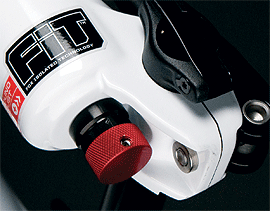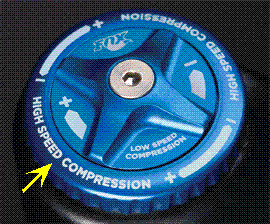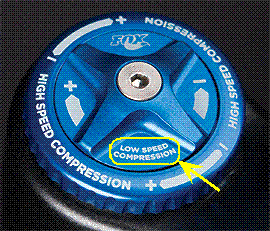




|

|

|

|
Installing Your Fork | Before You Ride | Setting Sag | Adjusting Rebound | Adjusting High-Speed Compression | Adjusting Low-Speed Compression | Changing the Coil Spring | Service Intervals | Important Safety Information
|
|
travel |
|
|
|
model features, adjustments |
|
||
|
lower leg |
20QR thru axle system, post style disc brake mounting |
||
|
spring |
coil |
||
|
riding styles |
AM, FR |
NOTE: This fork is designed to use the downhill brake system only. The disc brake caliper mounts directly to the fork leg and is positioned specifically for the use of 200-225 mm rotors.
Be sure your fork is properly installed before proceeding. If your fork came pre-installed on your bicycle, continue to the next section.
NOTE: Do not use any solvents or de-greasers, as these products can cause serious damage to paint and anodized parts (upper tubes, knobs, steerers).
Do not spray water directly on the seal/upper tube junction. Do not use a high pressure washer on your fork.
You can also view a Flash video on Setting Sag.
To get the best performance from your fork, it is necessary to set and adjust sag. Generally, sag should be set to 15 – 25% of total fork travel.
Travel | XC/Race FIRM | Freeride PLUSH |
160 mm (6.3") | 24.0 mm (0.94") | 40.0 mm (0.75") |
170 mm (6.7") | 25.5 mm (1.00") | 42.5 mm (1.67") |
180 mm (7.1") | 27.0 mm (1.06") | 45.0 mm (1.77") |
If your sag measurement value is less than the Sag Setup table value: turn the preload knob counter-clockwise one (1) full turn. Measure sag again and repeat this adjustment if necessary.
If your sag measurement value is greater than the Sag Setup table value: turn the preload knob clockwise one (1) full turn. Measure sag again and this repeat adjustment if necessary.
NOTE: If you cannot achieve correct sag by adjusting the preload knob, you may need to change your VAN coil spring to one with the appropriate spring rate for your weight and fork travel.
See the Sag Troubleshooting table, and given the travel length of your fork, see either the 36 Van Coil Spring Setting Guidelines, 160 mm or 36 Van Coil Spring Setting Guidelines, 170 & 180 mm table. If you are uncertain as to which coil spring is the original specification, see Changing the Coil Spring.
Symptom | Remedy |
Too much sag | Change to higher rate coil spring |
Too little sag | Change to lower rate coil spring |
Excessive bottoming | Change to higher rate coil spring |
Harsh ride; full travel not utilized | Change to lower rate coil spring |
FOX Part # | Spring Rate ±8% | Color Code | Rider Weight |
039-05-100 | 35 lb/in | Black | <90–115 |
039-05-101 | 40 lb/in | Purple | 115–155 |
039-05-102 | 45 lb/in | Blue (default) | 150–180 |
039-05-103 | 50 lb/in | Green | 175–210 |
039-05-104 | 55 lb/in | Yellow | 205–240+ |
FOX Part # | Spring Rate ±8% | Color Code | Rider Weight |
039-05-090 | 31.4 lb/in | Black | <90–115 |
039-05-091 | 35.9 lb/in | Purple | 115–155 |
039-05-092 | 40.4 lb/in | Blue (default) | 150–180 |
039-05-093 | 44.8 lb/in | Green | 175–210 |
039-05-094 | 49.3 lb/in | Yellow | 205–240+ |
NOTE: 36 VAN forks cannot be reduced in travel.

The rebound knob (shown below) is located on the bottom of the right fork leg, and has 18 clicks of adjustment. Rebound controls the speed at which the fork extends after compressing. Turning the knob clockwise slows down rebound; turning the knob counter-clockwise speeds up rebound. As a starting point, turn the rebound adjuster knob all the way clockwise (full in) until it stops, then turn counter-clockwise (out) 9 clicks.
The rebound knob is protected by a black protective cap. Never ride your FOX 36 VAN without this black protective cap installed (170 and 180 only).
|
Knob Setting |
Setting Description |
Tuning Tips |
Setup Tips |
|
|
Slow Rebound |
Too slow and your fork will pack down and ride harsh. |
If you increase your spring rate or air pressure, you will need to slow down your rebound |
|
9 (Factory setting) |
Average Rebound |
||
|
|
Fast Rebound |
Too fast and you will experience poor traction and wheel hop. |
If you decrease your spring rate or air pressure, you will need to speed up your rebound setting. |

High-speed compression damping controls the force it takes to move the fork through its travel and how the wheel reacts to a bump. This adjuster rotates to stops at each end and has 24 clicks of adjustment. It is set from the factory at 12 clicks out from the full closed (clockwise) position.
|
Knob Setting |
Setting Description |
Tuning Tips |
|
|
Soft Compression |
Maximum wheel traction and bump compliance. If setting is too soft, you may bottom often on square-edged hits and G-outs. |
|
12 (Factory setting) |
Average Compression |
|
|
|
Firm Compression |
Reduces bottom-out and provides maximum bump absorption. If setting is too firm, you may experience a harsh ride with bad traction and use too little available travel. |

Low-speed compression damping controls the influence of the rider’s weight shifts and bike attitude under braking. This adjuster rotates to stops at each end and has 24 clicks of adjustment. It is set from the factory at 12 clicks out from the full closed (clockwise) position.
|
Knob Setting |
Setting Description |
Tuning Tips |
|
|
Soft Compression |
Maximum wheel traction and bump compliance. Too soft and you maybe have excessive brake dive and wallowy feel. |
|
12 (Factory setting) |
Average Compression |
|
|
|
Firm Compression |
Resists brake dive and keeps the fork up in the travel. Too firm and you may have poor traction in loose conditions. |
Bushing Technology & Inspection | Control Direction | Oil Volumes | Structural Inspection | Dropout Thickness Inspection | Torque Values | Unit Conversion | Suspension Tuning Tips | Using the Pump | Important Safety Information | Service Intervals | Contact FOX Service | Warranty Information | FOXHelp Service Web Site
Copyright © 2011
FOX Factory Inc.